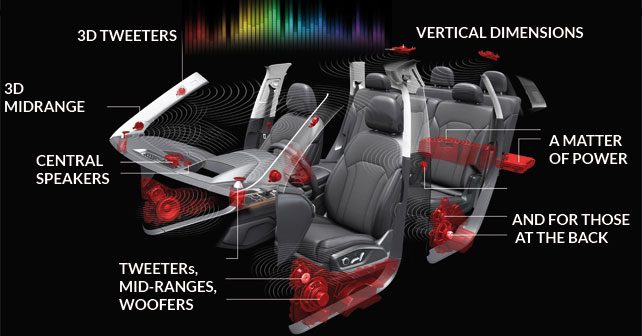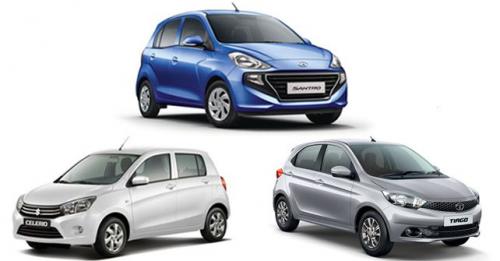
3D TWEETERS
Part of the equipment that generates a three-dimensional surround sound effect, these micro speakers enhance the spatial dynamics of sound as they’re positioned at a height compared with the primary tweeters. In practice, they can reproduce the acoustic sensation of a cinema or concert hall.
3D MIDRANGE
They perform the same function as of that of the 3D tweeters, but their functional domain lies within mid-range frequencies – in particular from 300 Hz to 10 KHz.
CENTRAL SPEAKERS
In any surround system, and whenever the dashboard dimensions allow it, these elements strengthen the front soundstage for a very good reason – the presence of several speakers on the sides at high power can lead to a sensation of acoustic vacuum in the central area. Furthermore, they are the ideal tool to listen to a telephonic conversation over the speakers and for indication using voice guidance via the navigation system. In Dolby 5.1 systems, they carry out the function of the central speaker.
TWEETERS, MID-RANGES, WOOFERS
Tweeters are usually located below the windscreen, and partially exploit their reflective capabilities (or, in the case of this Audi system, they feature a proper acoustic lens). Their response goes from approximately 5 KHz to more than 20 kHz. They are indeed speakers that add brightness and colour notes to music tracks and are quite directional (the ear perceives the source direction in a precise way, hence, they’re perfect to add spatiality to the soundstage).
Mid-range speakers are supposed to execute the best possible sound quality. Consequently, they don’t need high power to function – they can work at just 25-50 watts per channel. They typically reproduce frequencies between 300 Hz and 5 kHz, in which both human voice and almost all musical instruments are featured. If these are the only speakers available, their minimum diameter should be 13 centimetres in order to offer a musical reproduction worthy of the low notes.
Woofers are speakers assigned to output the higher octaves that the human ear can record, which means the lowest and most vibrant notes – as a result, they need pretty good power to operate (200 Hz and beyond). They reproduce notes ranging between 2 Hz and 60 Hz, according to both the material and the diameter of the cone – which can vary from 16cms to more than 40cms. The best woofers, though, are excessively heavy and eat a lot of space.
VERTICAL DIMENSIONS
The best in terms of spatiality – two speakers dedicated to the surround sound system, which are placed in the rear of the roof.
A MATTER OF POWER
Subwoofers, commonly located below a seat, or in the boot, due to their poor directivity, have been recently added to in-car and home sound systems – resulting in quite effective music reproduction whenever we need to be shaken up in order to feel that bass. The musical genres that get the most benefit from their presence are the rhythmic ones, like rock and techno. But, if equalised and amplified appropriately, woofers will be a valuable asset for every kind of music – as well as for cinema (in case of the car is equipped with a TV or video screen as well). The amplifier is the real engine of the audio system. According to its usage, it can provide several inputs, and the outputs are custom made for the speakers.
AND FOR THOSE AT THE BACK
Tweeters, mid-range and woofers work for the rear seat passengers, although through a separate amplification network.
Twenty-three channels, and a power of 1900 watts. For those who seek the best, here’s a three dimensional look at the Bang & Olufsen sound system from an Audi Q7. Does that mean, then, that you have to break the bank in order to get good sound quality inside a car? Not necessarily, if you understand the basics, you can create a reasonable set up in your car without breaking the bank.
Also read: History of in-car audio
© Riproduzione riservata
























Write your Comment